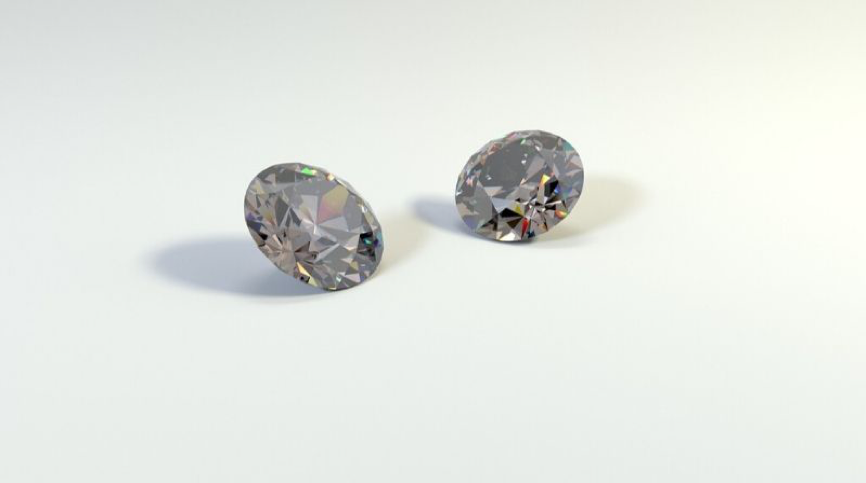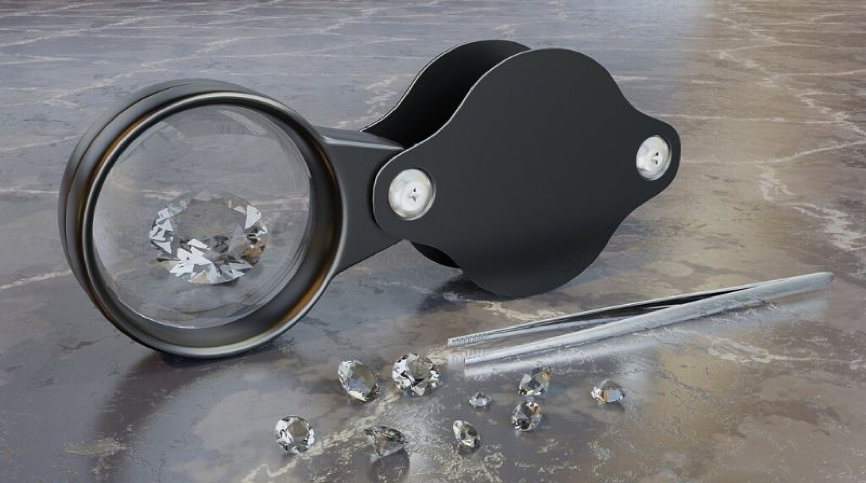The production process of lab-grown diamonds
There are two ways through which lab-grown diamonds are created. First, through high pressure and high temperature (HPHT) and second through Chemical Vapor Deposition (CVD).
HPHT
This process involves placing a small diamond seed into carbon, where it gets a temperature of around 1500°C and a pressure more than 70,000 times as that of sea level. At such an extreme condition, the carbon melts and formation of diamond happens around the seed. Once done, the diamond is cooled to get the crystal.
CVD
CVD happens inside vacuum plasma reactors. A diamond seed is kept inside the sealed chamber, and hydrocarbon gas is released in it. When the temperature rises up to 800°C, the ionization of gases happens through plasma. Powerful microwaves break the molecular bonds of gases and pure diamond deposits over the diamond plates, which later on crystallizes.
Reasons to Choose a Lab Created Diamond

Less expensive
When we talk about processes like cutting, polishing, and testing, both the natural and lab-grown diamonds have the same cost. Natural diamonds involve lengthier supply chain processes as these are obtained through the mining process. While lab-grown diamonds forgo mining and thus saves the overall cost of labor. This makes lab-grown diamonds a wallet-friendly option for the customers without compromising on the quality of diamonds.
Eco-friendly
The entire mining process has a significant impact on the environment. Mining companies put their efforts to minimize this impact to save the environment. However, the mining process is avoided in lab-grown diamonds, and less energy is required to create them, as no digging is required to obtain the diamond.
Certification and Grading of Lab Diamonds
The same process is involved for grading and certification of lab created diamonds as that of natural one. These diamonds are sent to gem labs, and these labs give their grade depending upon the cut, color, clarity, and carat of diamond. Different gemologist gives a grade for each diamond, and the individual grades are analyzed to decide the final grade of a diamond.
This process is followed to obtain an unbiased grading system. However, it is possible to get a different grade for the same diamond not only from different labs but also from the same lab if sent for a second opinion.
Lab-Grown diamonds vs. Natural diamonds
It is hard to find any difference between lab-grown and natural diamonds. Both have the same fire, sparkle, and scintillation. Lab diamonds may contain trace elements, but this will never reflect in their appearance. The only way to differentiate two diamonds is through specialized equipment. Lab-grown diamonds come with a gem certification, which tells customers that they are lab-grown.
Frequently Asked Questions
Are lab-grown diamonds less expensive than natural diamonds?
Yes! The major discrepancy between a lab-grown diamond & a naturally-mined diamond is solely the manner it is formulated. A mined diamond is formed beneath the Earth’s coating. These types of diamonds come to the surface and can be mined when unusual volcanoes erupt and give rise to them coming to the ground.
Lab grown diamonds often cost approximately 30% lower than natural diamonds of identical size & integrity. They are certified & graded to the similar precepts as mined diamonds, and they have that same sparkle you’d notice in a natural diamond. Even after being a professional gemologist, you can’t tell the disparity between lab-created diamonds and natural diamonds without technological tools! The adequate manner to illuminate the discrepancy between lab-grown and natural diamonds is to glare at its grading report.
All lab-grown diamonds and naturally mined diamonds are rated at retail prices & wholesale prices founded on an internationally approved pricing policy understood as the Rapaport pricing method. Retail, wholesale and resale rates are specified based on a discounted amount of the Rapaport price. However, you will possibly still get a return for a mined diamond vs a lab grown diamond since you’re inclined to spend an approximate 30% extra for a natural diamond.
How do you identify lab-grown diamonds?
The naked eye cannot differentiate the two, and natural Earth diamonds and lab-grown diamonds are visually equivalent. The decent manner to thoroughly specify artificial diamonds is through examining with high technological appliances, and magnetic examining.
It cannot be exaggerated that lab-grown diamonds retain an embodiment that’s visibly indistinguishable from natural Earth diamonds. It’s barely synonymous, it’s equivalent, and it is because stimulants are not certainly diamonds as they aren’t made entirely of carbon, but man-made ones are.
However, buyers can feel optimistic about their lab-grown diamond possession. Large lab-grown diamonds over 0.50ct appear with a grading document that reveals the diamond’s heritage and aspects such as cut, clarity, color, and carat. Several labs go so far as describing the diamonds to commemorate them as lab-grown. Whereas the price of lab-grown diamonds is considerably lower than that of earth-mined diamonds, buyers can be ascertained it is not due to a minor quality commodity.
To the naked eye, there is no discrepancy between the two kinds of diamonds. Nonetheless, there are a few tests for highly qualified scientists and geologists to specify the ancestry of a diamond.
Among them, the two types of tests that are performed in the laboratory are:
- Type IIa test
Every lab diamond is Type IIa giving rise to a better quality than ordinary earth-mined diamonds. This is one way where gemologists can specify lab-grown diamonds.
- UV radiation test
There are a few advanced machines especially invented to check whether the diamond is Earth grown or lab-grown. The machines like Diamondcheck and Diamondsure have prevailed for testing motives. The procedure begins with the machines whacking the diamonds with UV radiation, which are not destructive to humans, and survey the spectroscopic estimation. Furthermore, if the output illustrates stakes at particular wavelengths, the experimenter speculates that the diamond is lab-grown.
Are lab-grown diamonds flawless?
No, lab-grown diamonds are not entirely flawless. They can be but most are not flawless.
Like natural mined diamonds, lab-grown diamonds are inescapable from flaws and inclusions. Therefore both types of diamonds are at the tenderness of science, whether millions or billions of years or in a laboratory. There’s no way to ensure a precise diamond at any moment, and this is the reason behind diamonds being graded utilizing the 4 c’s that are color, carat, cut and clarity.
No diamond is perfect; lab-grown diamonds are estimated and authorized using a precise procedure like natural diamonds. So lab-grown diamonds aren’t flawless. Because diamonds are evolved by simulating the ailments of the essence, lab-grown diamonds have similar deviations of color and clarity that prevail in real & natural diamonds.
One of the prime benefits of lab grown diamonds is that they are practically indistinguishable from real diamonds because they are optically and chemically equivalent. Devoid of highly progressive appliances, even the extensively trained diamond analyzers cannot recognize whether a diamond was evolved in a lab or naturally shoveled.
Could lab diamonds test as Moissanite?
Moissanite is not the same as a lab-grown diamond. Moissanite has accumulated prominence in recent years, but it fluctuates from diamonds in a bunch of manners. While mined diamonds arrive from the surface and lab-grown diamonds are made in a lab, Moissanite is seen to originate from meteors. It, however, is not a diamond, neither is it seeking to be one.
Diamond exploration testers weld thermal conductivity. Heretofore lab-grown diamonds retain the exact properties as natural diamonds; lab-grown diamonds will constantly graze as diamonds on a thermal quest. By discrepancy, Moissanite probe testers estimate electrical conductivity (i.e. the capacity of a substance to transport electricity). Thus, the enormous preponderance of lab-grown diamonds will not be assessed as Moissanite because they require electrical conductivity. There’s one minor oddity here, the “Type IIb” lab-made diamonds, because the “Type IIb” lab-made diamonds comprise Boron contaminants. These generally blue (though not often; few may also be colorless) made in lab diamonds seem to be electrically conductive and shall experiment as Moissanite.
Moissanite will repeatedly be misinterpreted as a diamond by fundamental diamond testers as they merely examine heat conductivity, and Moissanite is relatively identical to diamonds in that region. Drilling electrical conductivity is a particular additional means to differentiate the two jewels, and a handful of multi-testers can estimate both.
Therefore, the enormous preponderance of lab-grown diamonds won’t test as Moissanite as they lack the essential electrical conductivity.
What are the benefits of lab-grown diamonds?
Today, generated diamonds are intensely being obtained to give rise to great chunks of jewelry. There are numerous reasons why these man-made & lab-grown diamonds are accumulating more to be prominent by the day. Here are only a limited number of the advantages that lab-grown diamonds have over their realistic resemblances.
Enormous virtue and enhanced quality
Lab-grown diamonds are more authentic than the jewels mined artlessly because, distinct from mined stones, synthetic diamonds don’t possess any dirt or pollutants entrenched in them. They moreover have rarer deficiencies and indicate little signs of a problem in their crystal pattern because they are prepared under carefully controlled regulations. Enormous virtue implies that the diamond is stabilized to be brighter, adequate, and whiter. The invalidity, a huge amount of lab-grown diamonds generally obtain high virtue ratings than their realistic replicas.
Ensured origins and guilt-free configuration
Ample diamond connoisseurs yearn to be familiar with the voyage of their jewel from its origins to its accession. Unfortunately, the heritage of maximum inherently burrowed diamonds can be ambiguous, as they appear from ambivalent regions. Frequently named ‘blood diamonds,’ these rocks have a dingy environment and may retain being sold to finance armed wars or public disruptions. Also, the diamonds from rocky areas might hold a record of human rights offence, child labor and poor functioning circumstances. Man-made diamonds, nonetheless, have a sterile history and a safeguarded, trackable source.
Inexpensive diamonds in numerous colors
While the colored diamonds are sold at intensified rates because of their odd integrity, thankfulness to technology, lab-grown diamonds are vacant for a portion of the price of natural colored diamonds. And what is promising is that they are luminous and additionally more precise than natural colored stones. The colored diamonds grown in the lab are genuine, smooth in color and susceptible to find.
Bottom Line
Are you shifting your focus towards lab-grown diamonds? If yes, then purchase them without any hesitation. These mining free diamonds have the same chemical, physical, and optical properties as that of natural ones. These diamonds are more affordable as that of natural ones with the same size and quality. You can see the price difference between them at Diamond Hedge, they have the largest selection of lab-grown diamonds. It is the perfect choice and perfect gift to your loved one.
Subscribe for free to receive new blog posts.
